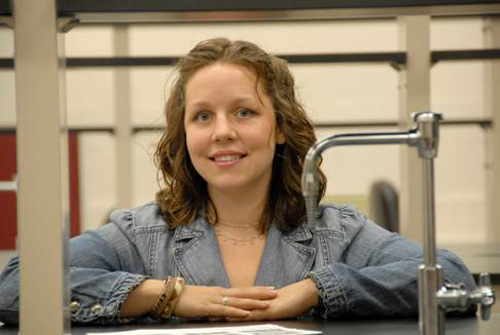New Assistant Professor of Chemistry Teaches at Interface with Biology
 |
| Erika Taylor, assistant professor of chemistry, is interested in finding antibiotics for the disease cholerae. |
| Posted 11/05/07 |
| Erika Taylor has joined the Department of Chemistry as an assistant professor of chemistry.
Taylors research interests include the exploration of lipopolysaccharide (LPS) biosynthesis and discovering new antibiotics for gram negative bacteria. My passion is exploring new ways of fighting diseases, with everything from drug development to education, she says. My research at Wesleyan will focus on the development of new antibiotics, especially for pharmaceutically undervalued diseases like cholerae, which infects 3 to 5 million people each year with a 5 percent mortality rate. Taylor comes to Wesleyan from the Albert Einstein College of Medicine at Yeshiva University, where she was a post-doctorial research associate for the past three years. There, Taylor studied nucleotide metabolism in the context of drug development for malaria. She also worked as a graduate research assistant at the University of Illinois, and studied the evolutionary relationship of enzymes in the enolase superfamily. Taylor has a Ph. D. in chemistry from the University of Illinois at Urbana-Champaign. Her thesis was titled “Characterization of ortho-succinylbenzoate synthase: A study of mechanism, proficiency and evolutionary diversity.” She received her bachelor of science in chemistry from the University of Michigan. Her honor’s thesis was titled “Synthesis towards analog molecules of motuporin for determination of a structure-function relationship with protein phosphatase I. This fall, she is advising two undergraduates on their research toward characterization of V. cholerae glycosyl transferases. Her lab investigates the contribution to virulence of the lipopolysaccharide (LPS) in Vibrio cholerae. She hopes to characterize the composition and structure of all regions of LPS from species in the genus. The lab will identify and mechanically explore LPS biosynthetic enzymes, including those involved in sugar precursor anabolism and the glycosyl transferase enzymes. Finally, the Taylor group will investigate environmentally induced alterations of LPS structure, the LPS biosynthetic gene and protein expression profiles, and the LPS metabolite profiles. She also is teaching CHEM321, a self-designed course that focuses on drug design, mode of action, and other health topics like diet and vitamins. Taylor said she was attracted to Wesleyan for its excellent research facilities, and she enjoys working in a liberal arts environment, which has a Ph.D.-granting program. I also thought the people in the Chemistry Department were really welcoming and good-natured. They asked great questions of me on my interview, and at the same time, seemed like people I would enjoy working with, she says. Taylor has always enjoyed teaching and mentoring equally to research. She mentored students at the University of Michigan as an undergraduate. As a graduate student and a post-doc, her faculty mentors always assigned undergraduates to work with her because they could see Taylors interest and enthusiasm in spreading an appreciation of science. An interesting thing that often happened was that undergraduates that worked with other lab mentors would often come to me to ask for help with their research dilemmas, further reinforcing my belief that I should continue into academia, Taylor says. At Wesleyan, she has already worked with the campus group Americans for Informed Democracy on their Malaria Awareness Week initiative. This educational and fundraising effort led to the purchase of bednets to be donated to communities in need. Taylor is a member of the American Society for Microbiology, the American Association for the Advancement of Science and the American Chemical Society. She is the co-author of several papers including: Anopheles gambiae Purine Nucleoside Phosphorylase: Catalysis, Structure and Inhibition, in press in Biochemistry; Transition State Structures of Human, Bovine and Plasmodium falciparum Adenosine Deaminases, published in the Journal of the American Chemical Society; and Neighboring Group Participation in the Transition State of Human Purine Nucleoside Phosphorylase, published in Biochemistry, all in 2007. Taylor enjoys yoga, ceramics, animals, eating sushi and exploring new places. She also aims to help demystify science, therefore turning it from a subject that is feared to something that is appreciated. Almost all aspects of our life involve doing things that are science related or are impossible without current scientific innovations, she says. Like cooking, doing dishes, taking medicines, watching CSI, doing ceramics, sitting on a jury, thinking about energy and climate. |
| By Olivia Drake, The Wesleyan Connection editor |

